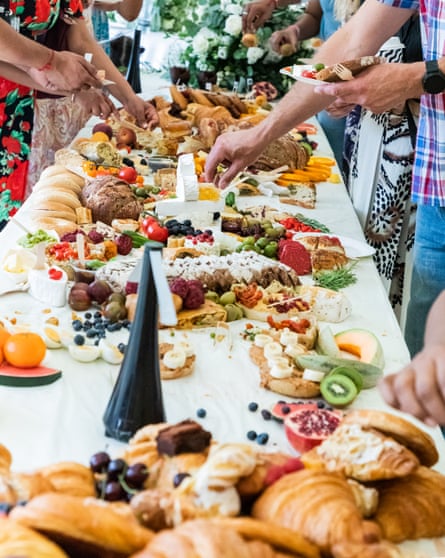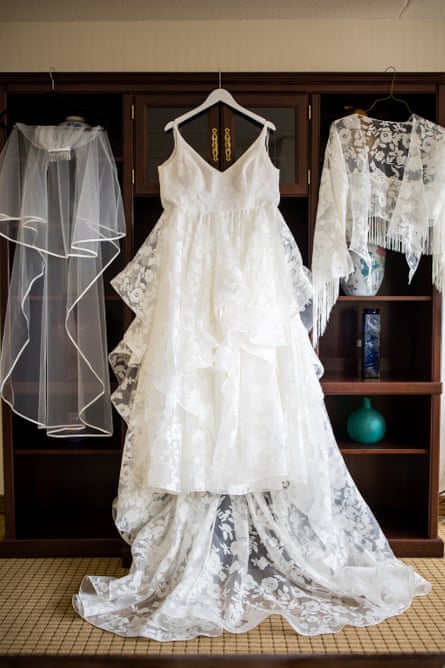A wedding is a couple’s big day. Unfortunately, it can also have a big carbon footprint.
The average American wedding creates around 60 metric tons of CO2 – the carbon equivalent of 71 round-trip flights from New York to LA. You’d need to plant roughly 60 trees and let them grow for 100 years to sequester that amount of carbon dioxide from the atmosphere. And with more than 2m marriages taking place in the US alone in 2022, the wedding industry’s environmental impact adds up.
Kat Wray’s eco-ethical wedding resource site, Mindfully Wed, features a free wedding footprint calculator anyone can use to estimate and reduce the impact of their nuptials. Wray, who is also a wedding photographer, says that the most carbon-intensive elements of a wedding are air travel, high guest count, menu items containing meat, food waste and imported flowers, in that order. Details like attire choices and decor can also add to a wedding’s carbon footprint.
“I encourage couples to consider wedding planning as an opportunity for joyful activism,” says Wray. “Weddings can be a way to use your consumer power to show your guests what’s important to you, and what you believe in.”
For those planning a wedding, experts suggested six key ways to make it more environmentally friendly.
Reduce travel emissions
Deciding on a location can be difficult and depends on many factors. But if you want to prioritize a low level of travel emissions, the best approach is choosing a venue close to where the majority of your guests live. Holding the ceremony, reception and photo session at the same place also cuts down on transportation.
If a particular destination is non-negotiable, couples can consider a venue that is central for most guests or group transportation, like shuttles, to reduce the number of vehicles attendees use. “If everyone’s coming from all corners of the world, you could decide to make the guest list smaller, so at least less people will be traveling,” suggests Wray.
Make your menu green
Opting for local caterers who source seasonal food further reduces transportation emissions. “It’s also about supporting the local economy, and building biodiversity locally,” says Michelle Miles, who runs the UK wedding vendor collective Sustainable Wedding Alliance. Because unpredictable factors like weather can affect the availability of local produce, Miles recommends couples keep their menus general: for example, “not committing to, say, local green beans, but rather saying ‘seasonal green vegetables’ so that you have the flexibility to deliver”.

Meat accounts for nearly 60% of all greenhouse gases from food production, with 1kg of beef creating 70kg of emissions, meaning that the most sustainable wedding feast is a vegetarian or vegan one.
If budget constraints make sustainable catering unfeasible, or meat must be on the menu, plan the meals to minimize waste and ask your venue if they can permit guests to take leftover food home or staff to eat it (many venues discard leftovers because of local health codes).
“Every staff member got a couple meals out of our event,” says Natalie Goldfarb, 30, who had an eco-conscious wedding in Poughkeepsie in 2022. Food-based party favors can also be a smart way to give your guests something they will use up, rather than a keepsake that could end up in the garbage. “I did glass bottles of tea leaves as a tchotchke,” says Goldfarb.
Choose local flowers for decoration
Flowers that have grown locally are more eco-friendly than those imported internationally. Cut flower farms are becoming more common in the US and the UK, for instance, so there may be a wider variety of blooms to choose from than you expect. You can also consider renting potted plants and silk bouquets.
If your favorite flowers are out of season or not local, consider using a mix of local greens and a few imported flowers, and look into organizations in your area that recycle wedding flowers for other venues, events or activities, such as flower-arranging at senior care facilities.
after newsletter promotion
Wear sustainable clothing

When it comes to wedding apparel, sustainability and extravagance don’t have to be mutually exclusive. Many businesses now specialize in vintage and resale formalwear. Goldfarb looked for her wedding dress at the New York non-profit Housing Works, which hosts an annual Bride on a Buck wedding sale, and ultimately had a dress made from recycled poly lining and natural fabrics by the Brooklyn design studio Loulette. For bridal parties, mismatched dresses are fashionable – bridesmaids can wear pieces they already own or select something they’ll wear again.
Speak now: A Guardian guide to the realities of a modern wedding
There was no time for a wedding – so we eloped
If you want a cheaper wedding, here’s how to do it
Couples break down their wedding costs and debt
How to host a sustainable wedding – including picking a second-hand dress
‘Shopping for a wedding dress mostly sucked’
Consider an heirloom ring
Vintage rings do not require any new materials to be made or mined, making them the most sustainable option for wedding jewelry.
When it comes to sourcing precious stones like diamonds, mining can be rife with environmental and social issues, and synthesizing them is extremely energy-intensive. This means the question of whether mined or lab-grown stones are more sustainable is not always clear cut. If you’re buying a new stone, seek out jewelers who use certified Sustainability Rated stones and adhere to the Kimberley Process to ensure their wares are conflict-free. While no gemstone mining is free of ethical and environmental concerns, precious stones such as sapphires and emeralds generally come from smaller, more traceable mines than diamonds, making it easier for consumers to research their origins and impact.
Just elope
The most sustainable wedding is an elopement, simply because they’re small.
Wray says her clients often confide that their dream wedding is an elopement, afterparty optional. This cuts out the need for sundries like groomsmen’s boutonnieres and seating charts and allows couples to use their budget for smaller-scale luxuries or other life needs. She encourages them to cast off the pressure to adhere to old traditions and define the purpose of their ceremony for themselves: “to decide, ‘What will be fun for us?’”
Some companies offer models that combine the low stress of elopement and the trappings of a traditional wedding with a sustainable twist. The Canada-based Pop-Up Chapel specializes in hyper-efficient ceremonies. It hosts 10 individual weddings for 10 couples over the course of one day, providing the venue, flowers, barware and music. For most, a city hall ceremony is the most readily accessible version of this sharing-economy style wedding. And for a dash of drama, get hitched in front of a Las Vegas Elvis who sees 20 couples a day. Cheap, fast and easy – it’s a classic for a reason.
